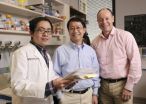Research leads to better understanding of peripheral neuropathy
2013-03-05
(Press-News.org) One in 25,000 people worldwide is affected by neurofibromatosis type 2 (NF2), a condition where the loss of a tumour suppressor called Merlin results in multiple tumours in the brain and nervous system.
Sufferers may experience 20 to 30 tumours at any one time and such numbers often lead to hearing loss, disability and eventually death. Those with NF2 may also experience peripheral neuropathy, which is when the nerves carrying messages to and from the brain and spinal column to the rest of the body do not work.
Peripheral neuropathy leads to further complications for NF2 sufferers, such as pain and numbness, muscle problems, problems with body organs and other symptoms of nerve damage, such as bladder problems, uncontrollable sweating and sexual dysfunction.
Researchers from Plymouth University Peninsula Schools of Medicine and Dentistry are part of an international research team which has for the first time identified the role of a tumour suppressor called Merlin in regulating the integrity of axons. Axons are nerve fibres which transmit information around the body and it is these are that damaged in peripheral neuropathy.
The research team showed that Merlin regulates a protein called neurofilament which supplies structural support for the axon.
A better understanding of this mechanism could lead to effective drug therapies to alleviate the symptoms of peripheral neuropathy in patients with NF2.
The results of the research is published this week in Nature Neuroscience.
###
In addition to researchers from Plymouth, the remaining research team came from the Leibniz Institute for Age Research, University of Bonn, Université Paris, Friedrich Schiller University Jena, Washington University School of Medicine, University Medical Center Hamburg-Eppendorf, University Hospital Aachen and Center for Neural Tumor Research, Los Angeles. END
ELSE PRESS RELEASES FROM THIS DATE:
2013-03-05
WEST LAFAYETTE, Ind. – Researchers have shown theoretically how to control or eliminate the formation of "dendrites" that cause lithium-ion batteries to fail, an advance that if realized would improve safety and might enable the batteries to be charged within a matter of minutes instead of hours.
The dendrites are lithium deposits that form on electrode surfaces and may continue to grow until they cause an internal short circuit, which results in battery failure and possible fire.
Researchers have created an analytical theory that shows how to design experiments to study ...
2013-03-05
DALLAS – March 5, 2013 – UT Southwestern Medical Center scientists report the first successful blocking of tumor development in a genetic mouse model of an incurable human cancer.
"To my knowledge, this is the first time that a mouse model of a genetically defined malignant human cancer has been generated in which the formation of the tumor from beginning to end can be monitored and in which blocking the pathway cures the mouse of the tumor," said Dr. Luis Parada, chair of the department of developmental biology at UT Southwestern and senior author of the study published ...
2013-03-05
COLUMBIA, Mo. -- As newspaper sales continue to decline, many news organizations are searching for ways to improve readership and revenues from their online presences. Now, University of Missouri researchers have found that news organizations should target readers with certain personality traits in order to optimize their online viewership. Paul Bolls, an associate professor of strategic communication at the MU School of Journalism and a 2011-2012 MU Reynolds Journalism Institute Fellow, has found that news consumers who have "reward-seeking" personalities are more likely ...
2013-03-05
New York, NY, March 5, 2013 – A JDRF-funded study out of Switzerland has shown that a single gene called SIRT1 may be involved in the development of type 1 diabetes (T1D) and other autoimmune diseases. The study, "Identification of a SIRT1 Mutation in a Family with Type 1 Diabetes," was published today in Cell Metabolism and represents the first demonstration of a monogenetic defect leading to the onset of T1D.
The research began when Marc Donath, M.D., endocrinologist and researcher at the University Hospital Basel in Switzerland, discovered an interesting pattern of ...
2013-03-05
NEW YORK, NY (March 5, 2013) — Researchers at Columbia University Medical Center (CUMC), with collaborators at the Albert Einstein College of Medicine of Yeshiva University, have discovered how the most common genetic mutations in familial Parkinson's disease damage brain cells. The mutations block an intracellular system that normally prevents a protein called alpha-synuclein from reaching toxic levels in dopamine-producing neurons. The findings suggest that interventions aimed at enhancing this digestive system, or preventing its disruption, may prove valuable in the ...
2013-03-05
It's among the most ancient of questions: What are the origins of life on Earth?
A new experiment simulating conditions in deep space reveals that the complex building blocks of life could have been created on icy interplanetary dust and then carried to Earth, jump-starting life.
Chemists from the University of California, Berkeley, and the University of Hawaii, Manoa, showed that conditions in space are capable of creating complex dipeptides – linked pairs of amino acids – that are essential building blocks shared by all living things. The discovery opens the door ...
2013-03-05
A combination of financial, cultural and communication barriers plays a role in preventing underserved Latino men with prostate cancer from accessing the care and treatment they need, according to a new study by researchers at the UCLA School of Nursing.
The study, "Barriers to Prostate Cancer Care: Affordable Care Is Not Enough," is published in the March issue of the peer-reviewed journal Qualitative Health Research.
According to the American Cancer Society, prostate cancer is the most commonly diagnosed cancer among Latino men. Additionally, Latino men are ...
2013-03-05
(Boston) – An international group of researchers has discovered seven new regions of the human genome—called loci—that are associated with increased risk of age-related macular degeneration (AMD), a leading cause of blindness. The AMD Gene Consortium, a network of international investigators representing 18 research groups, also confirmed 12 loci identified in previous studies. The study, which is published online in Nature Genetics and represents the most comprehensive genome-wide analysis of genetic variations associated with AMD, was supported by the National Eye Institute ...
2013-03-05
The uplift of the Isthmus of Panama 2.6 million years ago formed a land-bridge that has long thought to be the crucial step in the interchange of animals between the Americas, including armadillos and giant sloths moving up into North America and relatives of modern horses, rabbits, foxes, pigs, cats, dogs, and elephants down into South America.
However, in the March 2013 issue of the Journal of Vertebrate Paleontology, researchers from the University of Florida and the Smithsonian Tropical Research institute describe fossil crocodilians that shed a surprising new light ...
2013-03-05
A special supplement on patient safety strategies will be published with the March 5 issue. In addition to the 10 articles included in the supplement, Annals of Internal Medicine also will publish a special five-page graphic narrative on the topic of medical errors. Please see summaries at the bottom of the page for information. Full text of the graphic novel and articles in the supplement are available upon request.
1. Screening with Colonoscopy May Reduce Risk for Late-stage Cancer By 70 Percent
Screening with sigmoidoscopy yields similar results in cancer of ...
LAST 30 PRESS RELEASES:
[Press-News.org] Research leads to better understanding of peripheral neuropathy

